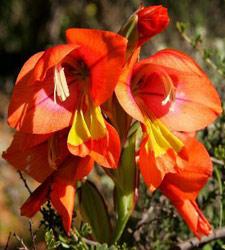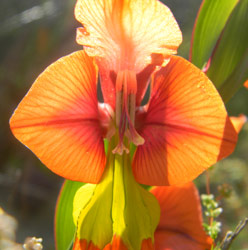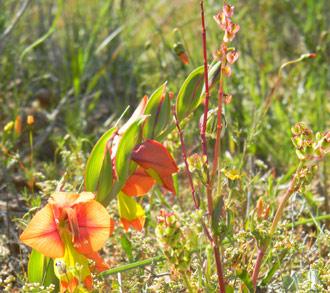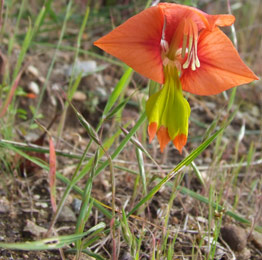Gladiolus alatus
Gladiolus alatus L.
Family: Iridaceae
Common names: common kalkoentjie, turkey-wattle flower (Eng.); kalkoentjie, kipkippies (Afr.)
Introduction
Gladiolus alatus is a very brightly coloured plant and will catch your eye wherever you walk, with its showy orange, yellow and green flowers. It populates the sandy flats of the Western Cape.

Description
Description
Gladiolus alatus is a compact perennial with corms approximately 10-20 mm across and covered with a reddish brown or brown membrane. The stem is slender, winged, usually 80-300 mm high and sometimes branched. The leaves are firm, sickle-shaped and ribbed, usually in clusters of 4 or 5, 80-400 mm long.
This species bears fragrant, 2-lipped, bright orange flowers with the upper tepals held upright. It also has 3 lower tepals, which are greenish yellow towards the base, and a tube 90-140 mm long. Stamens and anthers arise near the middle of the tube. Flowers are short-lived, lasting about a week. This species flowers in spring, from August to October.

The capsules are thin-walled and 10-25 mm long. The seeds are ovate to round, broadly winged and light glossy brown.
Conservation Status
Status
This species is not threatened.
Distribution and habitat
Distribution description
Gladiolus alatus is frequently seen in the Cape winter-rainfall area, and can be found widespread from southern Namaqualand south to the Cape Peninsula and east to Caledon and Bredasdorp. This species occurs on sandy or gravel flats and hill slopes, as well as plateaus. It can tolerate high temperatures and also a lot of water in the winter. This species also favours stony sandstone and granitic soils.

Derivation of name and historical aspects
History
Gladiolus in Latin means 'small sword', referring to the sword-shaped leaves of this plant. Alatus, Latin for 'winged', refers to the wing-shaped leaves and seeds. There are about 250 species of Gladiolus in Africa and Madagascar and into Eurasia, with about 160 species confined inside the borders of Southern Africa, about 100 of which are endemic to the Cape winter-rainfall area. This species is known as kalkoentjie, meaning little turkey, because its flowers resemble the wattle of a turkey. Gladiolus alatus was one of the first gladioli to be illustrated.
Ecology
Ecology
The bright colours and sweetly scented flowers of Gladiolus alatus can attract its pollinators from far away. Good observations have shown that the solitary bee primarily pollinates this plant in search of nectar. In this way pollen is transferred from one plant to another.
Certain species of Gladiolus in the Western Cape grow inside clumps of restios, which offer them protection from grazing animals and moles. The fruit of this plant matures quickly and all the seeds have a broad membranous wing, which contains air pockets, and ensures lightness, thus making it easier for the seeds to disperse and germinate.
Uses
Use
Gladiolus alatus does not have any medicinal value. It can be used in cultivation and is an ideal pot plant. It can also be used as a focal point in the garden with its bright colours. This species also has water-wise characteristics.

Growing Gladiolus alatus
Grow
Sow seeds in autumn, in a deep seed tray. Soil medium should be sterilized and consist of two parts river sand, one part loam and one part fine compost. Sow seed thinly to avoid overcrowding and allow sufficient room for the seedlings. Cover with a thin layer of sand. Corms should be removed from the mother plant in the dormant season when they are big enough. Corms can be stored in a dry place until the next planting season. Corms need to be planted in a well drained medium with a thin layer on top. The more sand incorporated into your medium the better the results will be.
Container cultivation is a very practical manner to grow Gladiolus alatus, as you can then move plants from one place to another. A rockery would be the ideal place for this species as it provides protection against moles and porcupines. Be sure to group plants according to their water requirements. Gladiolus alatus should be kept fairly dry in the dormant season.
In cultivation this species may be attacked by pests and fungi, but a good pesticide and fungicide can combat this.
References
- Lewis, G.J., Obermeyer, A.A. & Barnard, T.T. 1972. Gladiolus : A revision of the South African species. Purnell & Sons, Cape Town.
- Duncan, G. 2010. Grow bulbs. Kirstenbosch Gardening Series. National Botanical Institute, Cape Town.
- Manning, J. 2009. Field guide to wildflowers of South Africa. Struik Nature, Cape Town.
- Manning, J. 2007. Field guide to Fynbos. Struik Nature, Cape Town.
Credits
Ricardo Riddles
Karoo Desert National Botanical Garden
May 2012
Plant Attributes:
Plant Type: Bulb
SA Distribution: Western Cape
Soil type: Sandy
Flowering season: Spring
PH: Acid, Neutral
Flower colour: Green, Yellow, Orange
Aspect: Full Sun
Gardening skill: Easy
Special Features:
Horticultural zones








Rate this article
Article well written and informative
Rate this plant
Is this an interesting plant?
Login to add your Comment
Back to topNot registered yet? Click here to register.